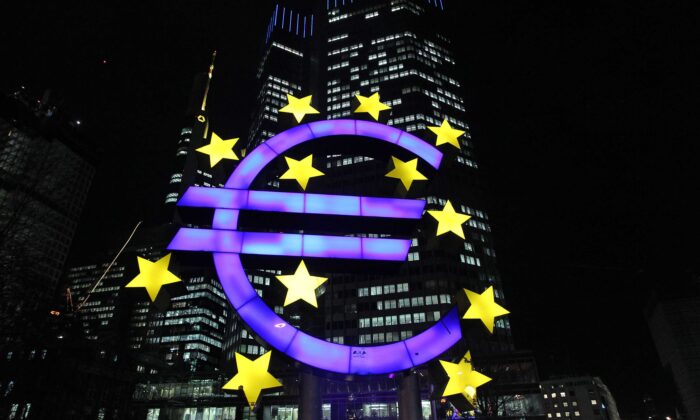European Central Bank Says Cash ‘Not Fit’ for Digital Economy, Dismisses CBDC Privacy Concerns
ECONOMICS, 29 Aug 2022
Andrew Moran | The Epoch Times - TRANSCEND Media Service

The euro logo is seen in front of the European Central Bank (ECB) in Frankfurt am Main, Germany, on Jan. 10.
(Daniel Roland/AFP via Getty Images)
25 Aug 2022 – In the digital economy, cash is no longer a useful tool, and a central bank digital currency (CBDC) is the “only solution” to continue the existing monetary system, according to a new paper from the European Central Bank (ECB).
The eurozone’s central bank recently published a paper titled “The Economics of Central Bank Digital Currency,” in which the authors assessed the implications for the financial system and examined data privacy and digital payments.
A CBDC, such as a digital euro, would be the “only solution” to facilitate a “smooth continuation” of the present monetary system, the researchers concluded. Amid debate that CBDCs would limit the credit supply and be a disruptive force in financial markets, the paper rejects those concerns as unfounded.
Digital money is critical in a digital economy, the ECB noted. Since “cash is losing its appeal as efficient means of payment,” a CBDC is a necessary tool to install. While the research identifies drawbacks of instituting a uniform digital monetary system, such as the sluggish pace of settlements, market developments, and adoption, the paper notes that “a digital update of cash” is crucial to advancing “the two-layer system of public and private money.”
Ultimately, cash possesses “large economic costs without clear benefits,” so “it is by construction not ‘fit’ for the digital age.”
Digital money might generate privacy concerns, the authors warn. However, researchers point to a “privacy paradox”: consumers will emphasize the importance of privacy in surveys, but they will give away personal data for free or in exchange for small rewards.

(Dado Ruvic/Reuters)
“From a public policy perspective, these observations warrant further scepticism concerning the ability of market forces to reach efficient levels of privacy protection,” the report notes.
The paper also rejects cryptocurrencies and stablecoins, calling them a “threat to monetary sovereignty.” It welcomed President Joe Biden’s digital asset working group to put together a regulatory framework for the crypto sector, as well as the myriad of other regulations being considered worldwide.
“These proposals would bring new forms of digital money into the regulatory perimeter and help to address some of the major concerns related to monetary sovereignty and financial stability,” the paper states.
The Rise of CBDCs
Across the globe, many governments and central banks have been studying CBDCs as a potential successor or complement to physical money.
In January, for example, the Federal Reserve released a discussion paper titled “Money and Payments: The U.S. Dollar in the Age of Digital Transformation.” It examined the pros and cons of a possible U.S. CBDC.
While delivering his semiannual monetary policy report to Congress in June, Fed Chair Jerome Powell recommended that a digital dollar is “something we need to explore as a country” that “should not be a partisan thing.”
“It’s a very important potential financial innovation that will affect all Americans,” he told the House Committee on Financial Services. “Our plan is to work on both the policy side and the technological side in coming years and come to Congress with a recommendation at some point.”
He added that if the United States were to create a digital dollar, it would need to be issued by the federal government and not by a private institution.
“One question around CBDCs is do we want a private stablecoin to wind up being the digital dollar? I think the answer is no,” Powell said. “If we’re going to have a digital dollar, it should be government-guaranteed money, not private money.”
Congress is requesting faster action on a digital dollar. A bipartisan group of members of Congress has urged the Fed to speed up work on a CBDC.
“With countries around the world competing to deploy digital versions of their own currencies, America can’t be left behind,” Waters said in a statement in May before a hearing on the advantages and risks of CBDCs.
Last month, ECB President Christine Lagarde championed a digital euro, stating that digitizing the official currency in 19 of the 27 member states of the European Union can “achieve” stability and public access.
A digital euro would complement cash rather than replace it, according to Lagarde. She also pointed out that a CBDC would only be successful if it addressed the needs of consumers and businesses and ensured that privacy safeguards were established from the beginning.
That, Lagarde co-wrote in a blog post, ensures that a digital euro “serves as an anchor for the whole payment system.”
US, Europe Take on Digital Yuan?
But while the United States and Europe might be attempting to take the lead on such a critical issue in the global monetary system, market analysts note that advanced economies might be responding to action by China.
After seven years of intensive study, the People’s Bank of China (PBoC) unleashed the digital yuan in 2021. The e-yuan is a CBDC that is trying to replace a portion of the cash presently in circulation, as fewer Chinese consumers use physical money. It’s estimated that cash represented about one-quarter of point-of-sale transactions in 2020, down from nearly 75 percent in 2012.
Some aver that Beijing is seeking to dismantle the global currency system, but officials say otherwise.
While speaking at a Shanghai forum in December 2020, former PBoC head Zhou Xiaochuan noted that technology is the main goal, not currency supremacy. However, Richard Turrin, author of “Cashless: China’s Digital Currency Revolution,” told CNBC in March that a digital yuan could challenge the U.S. dollar in international trade settlements in the next decade.
“Remember, China is the largest trading country, and you’re going to see digital yuan slowly supplant the dollar when buying things from China,” he said. “If we go about five to 10 years out, yes, the digital yuan can play a significant role in reducing the dollar’s usage in international trade.”
The yuan has become one of the most popular currencies in cross-border transactions in 2021, representing 2.7 percent of global payments, the highest level in six years, according to January statistics from the Society for Worldwide Interbank Financial Telecommunications (SWIFT). The U.S. dollar accounted for more than 40 percent of international transactions.
Any attempt to dethrone the U.S. dollar as the chief international reserve currency would take time. According to the International Monetary Fund’s (IMF) Currency Composition of Official Foreign Exchange Reserves (COFER) data, dollars accounted for nearly 60 percent of reserves in the first quarter of 2022. The yuan represented less than 3 percent.
Do CBDCs Offer Risks?
But while many public policymakers are ebullient over the prospect of CBDCs, critics acknowledge that there are many drawbacks.
The primary risk for CBC is an erosion of privacy. Whether by the federal government or law enforcement agencies, every consumer’s financial transaction can be monitored by the state. As with China’s nationwide credit score system, experts warn that it isn’t hard to see the government imposing digital money to facilitate the institution of social monitoring programs.
“The end of cash and the insta-analysis of financial transactions enable surveillance, state control, and, eventually, social engineering on a scale never thought possible,” Human Rights Foundation chief strategy officer Alex Gladstein notes. “When the government can take financial privileges away for posting the wrong word on social media, saying the wrong thing in a call to parents, or sending the wrong photo to relatives, individuals self-censor and exercise extreme caution.
“In this way, control over money can create a social chilling effect.”
Another factor is the faster adoption of monetary policies, especially in times of crisis such as the coronavirus pandemic.
“The switch also simplifies the execution of monetary policy–the central bank can immediately change supply by issuing or canceling codes in its own accounts,” wrote Ajay Mookerjee at the Harvard Business Review. “And by paying interest on CBDC holdings, however, the central bank can directly transmit monetary policy to households, instead of influencing commercial deposit rates through the rates it offers banks on their reserve accounts with the central bank.”
Although proponents contend that it could support the financial system, the World Bank has warned that it actually threatens the “financial integrity” of today’s banking infrastructure.
“The introduction of CBDC could disrupt the existing financial-intermediation structure. In addition, depending on design and country context, CBDC could pose risks to financial stability, financial integrity, data protection and privacy, and cyber resilience,” the World Bank explained in its “South Asia Economic Focus” report in April.
In the end, CBDCs could turn out to be a costly investment that fails to achieve anything of substance, the Center for European Reform says.
“Without widespread adoption, a CBDC will be an expensive failure, and will do little to advance central banks’ goals,” senior research fellow Zach Meyers stated. “The EU shouldn’t be distracted by the prospect of a digital euro—which may sound impressive and exciting, but may give Europeans few benefits they can’t enjoy already.”
With more nations assessing CBDCs and other markets already implementing it into the fabric of their economies, a monetary experiment may be unfolding in real time.
____________________________________________
 Andrew Moran covers business, economics, and finance. He has been a writer and reporter for more than a decade in Toronto, with bylines on Liberty Nation, Digital Journal, and Career Addict. He is also the author of “The War on Cash.”
Andrew Moran covers business, economics, and finance. He has been a writer and reporter for more than a decade in Toronto, with bylines on Liberty Nation, Digital Journal, and Career Addict. He is also the author of “The War on Cash.”
Go to Original – theepochtimes.com
Tags: Capitalism, Cryptocurrency, Economics, European Central Bank, European Union, Finance, Money, Plastic Money, Trade
DISCLAIMER: The statements, views and opinions expressed in pieces republished here are solely those of the authors and do not necessarily represent those of TMS. In accordance with title 17 U.S.C. section 107, this material is distributed without profit to those who have expressed a prior interest in receiving the included information for research and educational purposes. TMS has no affiliation whatsoever with the originator of this article nor is TMS endorsed or sponsored by the originator. “GO TO ORIGINAL” links are provided as a convenience to our readers and allow for verification of authenticity. However, as originating pages are often updated by their originating host sites, the versions posted may not match the versions our readers view when clicking the “GO TO ORIGINAL” links. This site contains copyrighted material the use of which has not always been specifically authorized by the copyright owner. We are making such material available in our efforts to advance understanding of environmental, political, human rights, economic, democracy, scientific, and social justice issues, etc. We believe this constitutes a ‘fair use’ of any such copyrighted material as provided for in section 107 of the US Copyright Law. In accordance with Title 17 U.S.C. Section 107, the material on this site is distributed without profit to those who have expressed a prior interest in receiving the included information for research and educational purposes. For more information go to: http://www.law.cornell.edu/uscode/17/107.shtml. If you wish to use copyrighted material from this site for purposes of your own that go beyond ‘fair use’, you must obtain permission from the copyright owner.